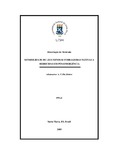| dc.creator | Cella Júnior, Adamastor Antoninho | |
| dc.date.accessioned | 2017-06-05 | |
| dc.date.available | 2017-06-05 | |
| dc.date.issued | 2005-02-25 | |
| dc.identifier.citation | CELLA JÚNIOR, Adamastor Antoninho. Sensitiveness of native forage legumes to post emergence herbicides. 2005. 77 f. Dissertação (Mestrado em Zootecnia) - Universidade Federal de Santa Maria, Santa Maria, 2005. | por |
| dc.identifier.uri | http://repositorio.ufsm.br/handle/1/10811 | |
| dc.description.abstract | The experiment was conducted in Departamento de Zootecnia of Universidade Federal de Santa Maria, in Santa Maria, RS, Brazil. The objective was to evaluate the sensitiveness of native legumes to herbicides sprayed in post emergency. The experimental design was arranged in split split plot disposed in Randomized Complete Blocks with three replications. The main plots were the herbicides triclopyr, fluroxipir MHE + picloran, 2,4 D + picloran and fluroxipir-éster. The sub plots were the doses zero; 480; 720 and 960 g ha-1 of acid equivalent of
triclopyr; zero; 80+80; 120+120 and 160+160 g ha-1 of acid equivalent of fluroxipir MHE + picloran; zero; 240 + 64; 360 + 96 and 480 + 128 g ha-1 of acid equivalent of 2,4 D + picloran and zero; 200; 300 and 400 g ha-1 of acid equivalent of fluroxipir-éster. The sub sub plots were composed by the legumes Aeschynomene falcata, Arachis burkartii, Desmodium incanum, Desmodium barbatum, Desmodium adscendens, Eriosema campestris, Stylosanthes leiocarpa, Stylosanthes montevidensis and Zornia diphylla. The results revealed that Arachis burkartii and Zornia diphylla were the more tolerant species to triclopyr, fluroxipir-éster, fluroxipir MHE + picloran and 2,4 D + picloran in the tested doses. The 2,4 D + picloran in the doses, 240 + 64, 360 + 96 and 480 + 128 g ha-1, was the herbicide that presented lower toxicity to the tested legumes. The triclopyr 480, 720 and 960 g ha-1 was selective to A. burkartii and 2,4 D + picloran, in the doses 240 + 64; 360+96 and 480 + 128 g ha-1 was selective to Z. diphylla and Eriosema campestris. Z. diphylla also was tolerant to fluroxipir MHE + picloran in the doses of 80 + 80 to 160 + 160 g ha-1. Fluroxipir-éster, in the doses of 200, 300 and 400 g ha-1 was selective to A. burkartii, S. leiocarpa and Z. diphylla, beeing this the product selective to the greater number of species. The doses 400; 240 + 64; 80 + 80 and 200 g ha-1, respectively, of the herbicides triclopyr, 2,4 D + picloran, fluroxipir MHE + picloran and fluroxipir-éster were selectives to all tested legumes. | eng |
| dc.description.sponsorship | Coordenação de Aperfeiçoamento de Pessoal de Nível Superior | |
| dc.format | application/pdf | por |
| dc.language | por | por |
| dc.publisher | Universidade Federal de Santa Maria | por |
| dc.rights | Acesso Aberto | por |
| dc.subject | Pastagem natural | por |
| dc.subject | Leguminosas | por |
| dc.subject | Fitotoxicidade | por |
| dc.subject | Natural pasture | eng |
| dc.subject | Legumes | eng |
| dc.subject | Fitotoxicity | eng |
| dc.title | Sensibilidade de leguminosas forrageiras nativas a herbicidas em pós-emergência | por |
| dc.title.alternative | Sensitiveness of native forage legumes to post emergence herbicides | eng |
| dc.type | Dissertação | por |
| dc.description.resumo | Com o objetivo de avaliar a sensibilidade de leguminosas nativas a herbicidas aplicados em pós-emergência foi realizado um estudo em 2003/04 na área do Departamento de Zootecnia da UFSM. O delineamento experimental foi em
parcelas sub-sub-divididas dispostas em blocos ao acaso com três repetições. As parcelas corresponderam aos herbicidas triclopyr, fluroxipir MHE + picloran, 2,4 D + picloran e fluroxipir-éster. Nas sub-parcelas, foram locadas as doses zero;
480; 720 e 960 g ha-1 do equivalente ácido de triclopyr; zero; 80+80; 120+120 e 160+160 g ha-1 do equivalente ácido de fluroxipir MHE + picloran; zero; 240 + 64; 360 + 96 e 480 + 128 g ha-1 do equivalente ácido de 2,4 D + picloran e zero;
200; 300 e 400 g ha-1 do equivalente ácido de fluroxipir-éster. As sub-subparcelas foram compostas pelas leguminosas Aeschynomene falcata, Arachis burkartii, Desmodium incanum, Desmodium barbatum, Desmodium adscendens, Eriosema campestris, Stylosanthes leiocarpa, Stylosanthes montevidensis e Zornia diphylla. Os resultados mostraram que Arachis burkartii e Zornia diphylla foram as espécies tolerantes ao triclopyr, fluroxipir-éster, fluroxipir MHE + picloran e 2,4 D + picloran nas doses testadas. O 2,4 D + picloran, nas
doses de 240 + 64, 360 + 96 e 480 + 128 g ha-1, foi o herbicida que apresentou menor toxicidade para as leguminosas testadas. O triclopyr (480, 720 e 960 g ha-
1) foi seletivo para A. burkartii e o 2,4 D + picloran, nas doses 240 + 64; 360 + 96; 480 + 128 g ha-1 foi seletivo para Z. diphylla e Eriosema campestris. Z. diphylla também foi tolerante a fluroxipir MHE + picloran nas doses de 80 + 80
até 160 + 160 g ha-1 . Fluoroxipir-éster, nas doses de 200, 300 e 400 g ha-1, foi seletivo para A. burkartii, S. leiocarpa e Z. diphylla, sendo este o produto seletivo para o maior número de espécies. As doses 480; 240 + 64; 80 + 80 e 200
g ha-1, respectivamente dos herbicidas triclopyr, 2,4 D + picloran, fluroxipir MHE + picloran e fluroxipir-éster, foram seletivas para todas as leguminosas testadas. | por |
| dc.contributor.advisor1 | Moojen, Eduardo Londero | |
| dc.contributor.advisor1Lattes | http://buscatextual.cnpq.br/buscatextual/visualizacv.do?id=K4727614D7 | por |
| dc.contributor.referee1 | Machado, Sérgio Luiz de Oliveira | |
| dc.contributor.referee1Lattes | http://buscatextual.cnpq.br/buscatextual/visualizacv.do?id=K4780229P3 | por |
| dc.creator.Lattes | http://buscatextual.cnpq.br/buscatextual/visualizacv.do?id=K4533525A7 | por |
| dc.publisher.country | BR | por |
| dc.publisher.department | Zootecnia | por |
| dc.publisher.initials | UFSM | por |
| dc.publisher.program | Programa de Pós-Graduação em Zootecnia | por |
| dc.subject.cnpq | CNPQ::CIENCIAS AGRARIAS::ZOOTECNIA | por |


